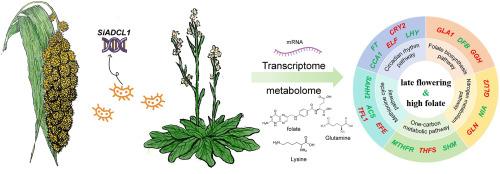Over-expression of SiADCL1 in Arabidopsis modulates folate and amino acid metabolism to impact on flowering time
IF 6.1
2区 生物学
Q1 PLANT SCIENCES
引用次数: 0
Abstract
Foxtail millet is a C4 crop rich in folate (FA). This study explores the roles of the 4-amino-4-deoxychorismate lyase (ADCL) – a member of the transaminase IV group of enzymes – in FA metabolism and conferred phenotypes. Phylogenetic comparisons identified diversity in the transaminase IV/ADCL gene family in the foxtail millet genome which was associated with genomic duplications. Molecular docking studies suggested that SiADCL1 bound most strongly to aminodeoxychorismate (ADC) and most likely had the highest catalytic activities. SiADCL1 which was highly expressed in roots, peduncles and flag leaves. Over-expression of SiADCL1 in Arabidopsis significantly increased total FA content (1.14–1.84 fold) and this was linked to a delayed flowering time. Metabolomic and transcriptomic characterization of the derived over-expression lines, found that FA promotes the change of methylation-related genes, ethylene synthesis, amino acid metabolism and flowering-related genes. This study revealed a potential gene coexpression network linked with FA and targeted key genes that could be exploited in foxtail millet breeding programs.

拟南芥中 SiADCL1 的过度表达可调节叶酸和氨基酸代谢,从而影响开花时间。
狐尾粟是一种富含叶酸(FA)的 C4 作物。本研究探讨了4-氨基-4-脱氧胆氨酸裂解酶(ADCL)--转氨酶IV群的一个成员--在叶酸代谢中的作用和赋予的表型。系统发育比较确定了狐尾粟基因组中转氨酶 IV/ADCL 基因家族的多样性,这与基因组重复有关。分子对接研究表明,SiADCL1 与氨基脱氧胆酸盐(ADC)的结合力最强,很可能具有最高的催化活性。SiADCL1 在根、花序梗和旗叶中高度表达。拟南芥中 SiADCL1 的过度表达会显著增加总 FA 含量(1.14-1.84 倍),这与开花时间延迟有关。对过度表达株系进行的代谢组学和转录组学分析发现,FA 可促进甲基化相关基因、乙烯合成、氨基酸代谢和开花相关基因的变化。这项研究揭示了与FA相关的潜在基因共表达网络,并锁定了狐尾粟育种计划中可利用的关键基因。
本文章由计算机程序翻译,如有差异,请以英文原文为准。
求助全文
约1分钟内获得全文
求助全文
来源期刊
CiteScore
11.10
自引率
3.10%
发文量
410
审稿时长
33 days
期刊介绍:
Plant Physiology and Biochemistry publishes original theoretical, experimental and technical contributions in the various fields of plant physiology (biochemistry, physiology, structure, genetics, plant-microbe interactions, etc.) at diverse levels of integration (molecular, subcellular, cellular, organ, whole plant, environmental). Opinions expressed in the journal are the sole responsibility of the authors and publication does not imply the editors'' agreement.
Manuscripts describing molecular-genetic and/or gene expression data that are not integrated with biochemical analysis and/or actual measurements of plant physiological processes are not suitable for PPB. Also "Omics" studies (transcriptomics, proteomics, metabolomics, etc.) reporting descriptive analysis without an element of functional validation assays, will not be considered. Similarly, applied agronomic or phytochemical studies that generate no new, fundamental insights in plant physiological and/or biochemical processes are not suitable for publication in PPB.
Plant Physiology and Biochemistry publishes several types of articles: Reviews, Papers and Short Papers. Articles for Reviews are either invited by the editor or proposed by the authors for the editor''s prior agreement. Reviews should not exceed 40 typewritten pages and Short Papers no more than approximately 8 typewritten pages. The fundamental character of Plant Physiology and Biochemistry remains that of a journal for original results.

 求助内容:
求助内容: 应助结果提醒方式:
应助结果提醒方式:


